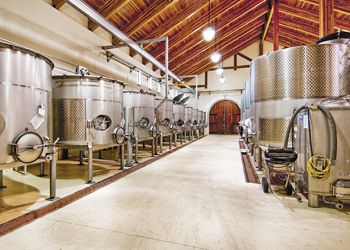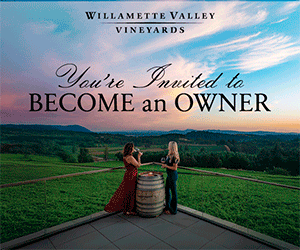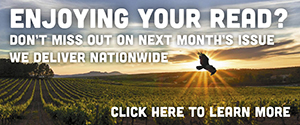A Year of Highs and Lows

By Karl Klooster
The 2010 vintage proved that Oregon winegrowers and winemakers have learned how to deal with adversity and make the best of it. It’s taken four decades, but conditions that might have once spelled disaster can now be minimized.
When those famed few industry pioneers first arrived between the mid 1960s and early 1970s, they only had an inkling of the daunting challenges they would face when trying to make great wine in a marginal climate. Only stubborn persistence and dogged determination saw them through.
Longtimers say 2010 was not the worst of years, climactically. Thus, numerous savvy growers harvested excellent fruit. However, the combination of sporadic set, a long, cool summer and unrelenting birds resulted in a lot less of it.
The scenario could be described as good grapes, bad birds. According to many accounts, the voracious avians were more relentless than any year in recent memory. Vineyard managers should have bought stock in noisemakers and shotgun shells.
Despite the fact that they were not our feathered friends this year, their love of ripe fruit was nature’s signal that the remaining grapes were very good, indeed. After the reds finish secondary fermentation this spring, the proof will be in the tasting.
As a consequence of the short crop, however, the lineup of 2010’s top producers shows some significant differences from past patterns. Though it came as no surprise that production was down for almost everyone, certain circumstances were unexpected.
King Estate held on to the top spot, both as a production facility and as a brand, dropping 13 percent below 2009. Other wineries in the top 10, including A to Z Wineworks, Willamette Valley Vineyards, NW Wine Company and Eola Hills, took more substantial hits, but in some instances this was by design, owing to slower sales and unsold inventories. A minimal loss at Wine by Joe saw them rise to the second spot.
Overall, 2010 production among Oregon’s 20 largest production facilities totaled 1,076,000 cases as compared to 1,450,000 in 2009, amounting to a 25.7 percent drop from 2009.
Top 20 Oregon Wineries by Total Production (2010)
(Processed at the winery’s primary production facility only.)
Winery Name • Location • Manager • Estimated Case Production
1. King Estate Winery • Lorane • Ed King III • 155,200
2. Wine by Joe/Dobbes Family Estate • Dundee • Joe Dobbes • 119,000*
3. NW Wine Company • McMinnville • Laurent Montalieu • 80,500*
4. A to Z Wineworks/Rex Hill • Newberg • Bill Hatcher • 79,500
5. 12th & Maple Wine Company • Dundee • Corus Estates • 78,600*
6. Willamette Valley Vineyards • Turner • Jim Bernau • 70,400
X. Erath Vineyards • Dundee • Ste. Michelle Estates • WND*
7. Eola Hills Wine Cellars • Rickreall • Tom Huggins • 55,500*
8. Argyle Winery • Dundee • Rollin Soles • 45,000
9. Foris Vineyards Winery • Cave Junction • Ted Gerber • 40,600*
10. Adelsheim Vineyards • Newberg • David Adelsheim • 37,500
11. Montinore Estate • Forest Grove • Rudy Marchesi • 35,600
12. Ponzi Vineyards • Beaverton • Ponzi Family • 35,000
13. Owen Roe Winery • St. Paul • David O’Reilly • 35,000*
14. Bridgeview Vineyards • Cave Junction • Rene Eichmann • 34,200
15. Firesteed Wines • Rickreall • Howard Rossback • 28,000
16. Elk Cove Vineyards • Gaston • Adam Campbell • 27,900
17. Duck Pond Cellars • Dundee • Lisa Jenkins • 26,000*
18. Domaine Serene • Dayton • Ken Evenstad • 24,000
19. Sokol Blosser • Dundee • Alex Sokol Blosser • 19,500
20. Benton-Lane Winery • Monroe • Steve Girard • 19,000
20. WillaKenzie Estate • Yamhill • Bernard Lacroute • 19,000
*2.) Wine by Joe: 80% for clients. 3.) NW Wine: 95% for clients. 5.) 12th & Maple: 73% for clients. X.) Erath: Would Not Disclose. Estimated production at Dundee winery: 70,000 cases. 7.) Eola Hills: 50% for clients. 9.) Foris: 35% for clients. 13.) Owen Roe and 17.) Duck Pond: Does not reflect Washington production for brands.
Top 20 Oregon Wineries by Brand (2010)
(All sources of fruit included.)
Once again, with its broad national presence, King Estate remained the largest Oregon wine brand well ahead of second place A to Z. Almost everyone on the list saw at least some reduction in quantity, with a few instances of major reductions. The single exception was Duck Pond, whose Washington production leapfrogged the brand into third. Joining the list for the first time is Olsen Family Vineyards of Monmouth, whose Viridian brand took the 17th position.
Winery Name • Location • Manager • Estimated Case Production
1. King Estate Winery • Lorane • Ed King III • 155,200
2. A to Z Wineworks/Rex Hill • Newberg • Bill Hatcher • 106,500
3. Duck Pond Cellars • Dundee • Lisa Jenkins • 87,000
4. Willamette Valley Vineyards • Turner • Jim Bernau • 70,400
X. Erath Vineyards • Dundee • Ste. Michele Estates • WND*
5. Sokol Blosser • Dundee • Alex Sokol Blosser • 65,000*
6. Bridgeview Vineyards • Cave Junction • Rene Eichmann • 59,400
7. Argyle Winery • Dundee • Rollin Soles • 45,000
8. Foris Vineyards Winery • Cave Junction • Ted Gerber • 41,600
9. Owen Roe Winery • St. Paul • David O’Reilly • 39,700*
10. Adelsheim Vineyard • Newberg • David Adelsheim • 37,500
11. Montinore Estate • Forest Grove • Rudy Marchesi • 35,600
12. Ponzi Vineyards • Beaverton • Ponzi Family • 35,000
13. Wine by Joe • Dundee • Joe Dobbes • 30,000
14. Firesteed Wines • Rickreall • Howard Rossback • 28,000
15. Eola Hills Wine Cellars • Rickreall • Tom Huggins • 27,900
15. Elk Cove Vineyards • Gaston • Adam Campbell • 27,900
16. Domaine Serene • Dayton • Ken Evenstad • 24,000
17. Olsen Family Vineyards/Viridian • Monmouth • Jamie Olsen • 22,000
18. 12th & Maple Wine Company • Dundee • Corus Estates • 21,800
19. Benton-Lane Winery • Monroe • Steve Girard • 19,000
19. WillaKenzie Estate • Yamhill • Bernard Lacroute • 19,000
*X.) Erath: Would Not Disclose. Estimated production at Dundee winery: 70,000 cases. 5.) Sokol Blosser: Includes Evolution and Meditirina brands (30% Oregon, 10% Calif., 60% Wash.) 10.) Owen Roe: Reflects Washington production.












